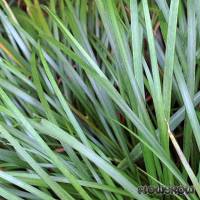



The Japanese sweet flag, Acorus gramineus, has a wide natural distribution that stretches from Southeast Asia and northeastern India throughout China, Japan and Korea up to the Russian Far East. It occurs in the nature mostly as a rheophyte (adapted to strong current) in the flooding zone of fast flowing, rocky forest streams and waterfalls where it is exposed to strong water current during spates.
Acorus gramineus is known as a medicinal plant in its area of origin, it is also an old ornamental plant. It is very easy to grow in moderately moist bottom. This species has several cultivars that differ from each other in coloration and size. Some cultivars of the grass-leaf sweet flag are sold in the aquarium trade for a long time. However, A. gramineus is generally regarded as a plant that tolerates to be immersed for a longer period but hardly grows during that time, eventually dying off. On the other hand, also permanent aquarium suitability, especially with rather low temperatures, is reported.
At least the dwarf cultivar Acorus gramineus 'Pusillus' is suited as aquarium plant. This presupposes that the rhizome is not buried into the substrate but fastened to objects such as wood or rock. The plant attaches itself by its roots. Whether this is also the case with the taller forms such as A. gramineus 'Variegatus' is unknown to us. Variants like this are recommended as emergent plants for open tanks or paludariums.
The Sweet Flag genus ((Acorus) only includes A. gramineus and the Sweet flag, A. calamus that is native to East Asia and North America and introduced to Europe. Three varieties are distinguished within A. calamus, and some authors treat the American Sweet flag (A. americanus) as a separate species. Acorus calamus is an emergent wetland plant that mostly gets taller and broader leaved than the Japanese sweet flag. It differs from A. gramineus mainly by a distinct, prominent midrib in the leaves. The Acorus species have the leaves arranged fan-like on creeping rhizoms, and their inflorescences are spadices. Acorus was seen as a member of the Aroid family (Araceae) for a long time but is nowadays in its own family, Acoraceae. Molecular analyses prove that Acorus is an ancient lineage that represents the sister group to all other monocotylodenous plants.
For further details, see under "Culture".
As mentioned, the dwarf cultivar Acorus gramineus 'Pusillus' can be grown permanently submerged when it is used as an "epiphyte" (attached to solid materials) and not buried into the ground. It is unknown to us whether this is also the case with the taller growing forms of the Japanese sweet flag, and we cannot unreservedly recommend the whole species as aquarium plant.
All forms of Acorus gramineus grow as terrestrial plants without difficulties and are suited as house or terrarium plants. The substrate may be customary potting soil, and it is by no means necessary to keep it wet. However it should not dry out. Several Japanese sweet flag cultivars are more or less hardy in Central Europe but should be protected against frost when they are grown outdoors.
<a href="https://www.flowgrow.de/db/aquaticplants/acorus-gramineus" target="_blank"><img alt="Acorus gramineus" title="Acorus gramineus" src="https://www.flowgrow.de/db/widget/aquaticplants/acorus-gramineus" /></a>
[url=https://www.flowgrow.de/db/aquaticplants/acorus-gramineus][img]https://www.flowgrow.de/db/widget/aquaticplants/acorus-gramineus[/img][/url]
[widget=aquaticplants/acorus-gramineus]Acorus gramineus[/widget]